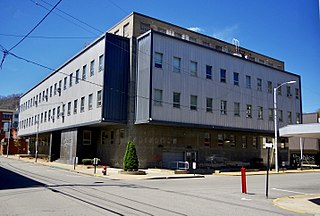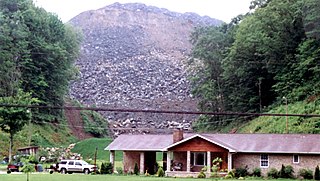Related Research Articles

Logan County is a county in the U.S. state of West Virginia. As of the 2020 census, the population was 32,567. Its county seat is Logan. Logan County comprises the Logan, WV Micropolitan Statistical Area, which is also included in the Charleston–Huntington–Ashland, WV–OH–KY Combined Statistical Area.

The Guyandotte River is a tributary of the Ohio River, approximately 166 mi (267 km) long, in southwestern West Virginia in the United States. It was named after the French term for the Wendat Native Americans. It drains an area of the unglaciated Allegheny Plateau south of the Ohio between the watersheds of the Kanawha River to the northeast and Twelvepole Creek and the Big Sandy River to the southwest. Via the Ohio River, it is part of the Mississippi River watershed.
The Buffalo Creek flood was a disaster that occurred in Logan County, West Virginia, on February 26, 1972, when a coal slurry impoundment dam burst, causing significant loss of life and property damage.

Massey Energy Company was a coal extractor in the United States with substantial operations in West Virginia, Kentucky and Virginia. By revenue, it was the fourth largest producer of coal in the United States and the largest coal producer in Central Appalachia. By coal production weight, it was the sixth largest producer of coal in the United States.

The Buffalo Creek Flood: An Act of Man is a 1975 American documentary film produced by Appalshop and directed by Mimi Pickering.
Accoville is an unincorporated community and census-designated place (CDP) in Logan County, West Virginia, United States. The community lies along Buffalo Creek. As of the 2010 United States Census, its population was 574.
Simon is an unincorporated community on the Guyandotte River in Wyoming County, West Virginia, United States. Ellery "Elvis" Hatfield, 47, of Simon along with Don Israel Bragg, 33, of Accoville were killed in the 2006 Aracoma Alma Mine disaster at Melville.
The Aracoma Alma Mine accident occurred when a conveyor belt in the Aracoma Alma Mine No. 1 at Melville in Logan County, West Virginia, caught fire. The conveyor belt ignited on the morning of January 19, 2006, pouring smoke through the gaps in the wall and into the fresh air passageway that the miners were supposed to use for their escape, obscuring their vision and ultimately leading to the death of two of them. The two men, Ellery Hatfield, 47 and Don Bragg, 33, died of carbon monoxide poisoning when they became separated from 10 other members of their crew. The others held hands and edged through the air intake amid dense smoke.
Aracoma is an unincorporated community in Logan County, West Virginia, United States. Aracoma lies along West Virginia Route 10 on the Guyandotte River north of Logan. Aracoma was named for Aracoma, the daughter of the Shawnee Chief Cornstalk.
Lyburn is an unincorporated mining community in Logan County, West Virginia, United States. Lyburn is also the home of the Bearwallow trailhead for the Hatfield-Mccoy ATV trail.
The Winding Gulf Coalfield is located in western Raleigh County and eastern Wyoming County, in southern West Virginia. It is named after the Winding Gulf stream, a tributary of the Guyandotte River. In the early 20th century, it was promoted as the "Billion Dollar Coalfield".

The New River Coalfield is located in northeastern Raleigh County and southern Fayette County, West Virginia. Commercial mining of coal began in the 1870s and thrived into the 20th century. The coal in this field is a low volatile coal, known as "smokeless" coals. The seams of coal that have been mined include Sewell, Fire Creek, and Beckley. This is very high quality bituminous coal rated at approximately 15,000 BTU (16,000 kJ). The New River coalfield is named after the north flowing New River. Over 60 coal towns were once located there, supported by independent commercial districts at Beckley, Oak Hill, Mount Hope, and Fayetteville. By the 21st century many coal camps had partially or completely returned to nature. These company towns were located along Dunloup (Loup) Creek, Laurel Creek, White Oak Creek, lower Piney Creek, and, of course, the New River. The mainline of the Chesapeake and Ohio Railway ran right through the center of this coalfield, with spurs branching off in many directions, and rail yards were maintained at Quinnimont, Raleigh, and Thurmond, WV. The Virginian Railway's main line also passed through the western side of the field as well. Companies such as the New River Company, New River & Pocahontas Consolidated Coal Co., and Mary Frances Coal Co. were the largest operators in the New River Coalfield, but there were many smaller ones as well. These companies recruited native born whites, immigrants from Southern and Eastern Europe, and African-Americans from the South to work in their coal mines and railroads. The mines began to close down after World War II and today there are very few active coal mines in the field. The New River Gorge is now the domain of the National Park Service as the New River Gorge National Park and Preserve, and they have done what their budget allows to preserve the coal heritage of the area.
Blackwater is a form of pollution produced in coal preparation. In its purification, coal is crushed in a coal preparation plant and then separated and transported as a coal slurry, From the slurry, incombustible materials are removed and the coal can be sized. After the recovery of the coal particles from this slurry, the remaining water is black, contains very fine particles of coal. This blackwater cannot be processed in a water treatment plant.
Monaville is an unincorporated community and census-designated place (CDP) in Logan County, West Virginia, United States. As of the 2010 census, its population was 309.
Climate Ground Zero (CGZ), founded in February 2009, is a non-violent civil disobedience campaign against mountaintop removal mining based in the southern coalfields of West Virginia. According to their website, Climate Ground Zero believes “that the irrevocable destruction of the mountains of Appalachia and its accompanying toll on the air, water, and lives of Appalachians necessitates continued and direct action". The organization seeks to end mountaintop removal mining by drawing attention to the issue through protests involving trespass on the property of mining companies. By locking down to machinery on mine sites, occupying trees in the blast zone, or blockading haul roads to mine sites, protesters associated with Climate Ground Zero directly interfere with mining practices. Other protests draw attention to the alleged negligence of regulatory agencies such as the West Virginia Department of Environmental Protection (WVDEP) or the federal Environmental Protection Agency (EPA) by occupying the offices of these governmental organizations. Climate Ground Zero has been referenced in the New York Times, Los Angeles Times, Washington Post, Democracy Now, and the Associated Press.

Buffalo Creek is a tributary of the Guyandotte River, 18.8 miles (30.3 km) long, in southern West Virginia in the United States. Via the Guyandotte and Ohio rivers, it is part of the watershed of the Mississippi River, draining an area of 45 square miles (120 km2) in the Logan Coalfield. The creek was the site of the Buffalo Creek Flood in 1972.

The Coal Wars were a series of armed labor conflicts in the United States, roughly between 1890 and 1930. Although they occurred mainly in the East, particularly in Appalachia, there was a significant amount of violence in Colorado after the turn of the century.
Mountain Justice is a grassroots movement established in 2005 to raise worldwide awareness of mountaintop removal mining and its effects on the environment and peoples of Appalachia. The group seeks to encourage conservation, efficiency, solar and wind energy as alternatives to all forms of surface mining. It self-describes as "a regional Appalachian network committed to ending mountaintop removal". It seeks justice because the mountaintop removal (MTR) it opposes is a form of coal mining known as mountaintop removal mining which produces coal sludge toxic waste which is stored in a dam on the mountain and leaches into the groundwater, which poisons the environment, which defaces the top of the mountain, and which is not stopped due to political corruption.

Environmental justice and coal mining in Appalachia is the study of environmental justice – the interdisciplinary body of social science literature studying theories of the environment and justice; environmental laws, policies, and their implementations and enforcement; development and sustainability; and political ecology – in relation to coal mining in Appalachia.

Environmental issues in Appalachia, a cultural region in the Eastern United States, include long term and ongoing environmental impact from human activity, and specific incidents of environmental harm such as environmental disasters related to mining. A mountainous area with significant coal deposits, many environmental issues in the region are related to coal and gas extraction. Some extraction practices, particularly surface mining, have met significant resistance locally and at times have received international attention.